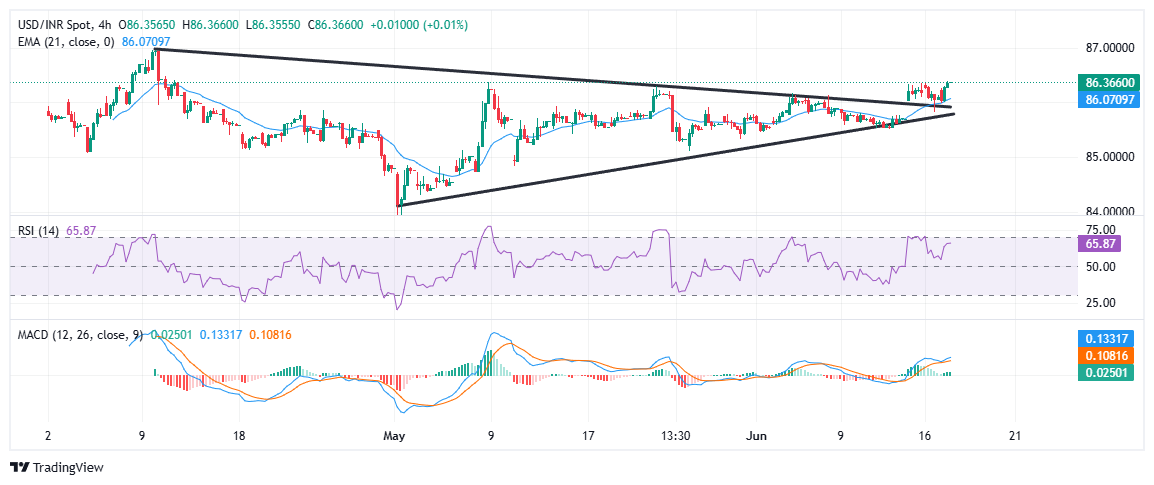Created
: 2025.06.17














![]() 2025.06.17 22:05
2025.06.17 22:05
The Indian Rupee (INR) weakens against the US Dollar (USD) on Tuesday, giving up Monday's modest rebound as heightened geopolitical tensions in the Middle East, stronger Crude Oil prices, and a resilient Greenback dampen sentiment ahead of the Federal Reserve's (Fed) key interest rate decision.
The USD/INR pair climbed to an intraday high of 86.46 -- a level last seen on April 11 -- and was trading around 86.41 at the time of writing, up nearly 0.38% on the day. However, the US Dollar eased slightly after US Retail Sales missed market expectations, dampening buying interest in the Greenback.
Tensions between Iran and Israel flared further on Tuesday after Israel reportedly assassinated Iran's wartime chief of staff, Ali Shadmani -- the second senior commander killed within days. In response, Iran launched a new wave of missile and drone attacks targeting Tel Aviv and Herzliya, triggering air-raid sirens and chaos in Tehran. Adding to the sense of urgency, former US President Donald Trump called for an immediate civilian evacuation of Tehran and insisted he wants a "real end" to the conflict rather than a temporary ceasefire. The heightened geopolitical risk has fuelled risk-off flows across global markets.

On the technical front, USD/INR has broken above a symmetrical triangle formation on the 4-hour chart, hinting at a continuation of the recent bullish momentum. The pair holds well above the 21-period EMA near 86.07, supporting the near-term positive bias. Momentum indicators remain encouraging, with the RSI hovering near 66 -- below overbought territory -- and the MACD histogram and signal lines building further upside traction. Sustained trade above the 86.20-86.30 zone could clear the path for a move toward the psychological 87.00 handle.
The Indian economy has averaged a growth rate of 6.13% between 2006 and 2023, which makes it one of the fastest growing in the world. India's high growth has attracted a lot of foreign investment. This includes Foreign Direct Investment (FDI) into physical projects and Foreign Indirect Investment (FII) by foreign funds into Indian financial markets. The greater the level of investment, the higher the demand for the Rupee (INR). Fluctuations in Dollar-demand from Indian importers also impact INR.
India has to import a great deal of its Oil and gasoline so the price of Oil can have a direct impact on the Rupee. Oil is mostly traded in US Dollars (USD) on international markets so if the price of Oil rises, aggregate demand for USD increases and Indian importers have to sell more Rupees to meet that demand, which is depreciative for the Rupee.
Inflation has a complex effect on the Rupee. Ultimately it indicates an increase in money supply which reduces the Rupee's overall value. Yet if it rises above the Reserve Bank of India's (RBI) 4% target, the RBI will raise interest rates to bring it down by reducing credit. Higher interest rates, especially real rates (the difference between interest rates and inflation) strengthen the Rupee. They make India a more profitable place for international investors to park their money. A fall in inflation can be supportive of the Rupee. At the same time lower interest rates can have a depreciatory effect on the Rupee.
India has run a trade deficit for most of its recent history, indicating its imports outweigh its exports. Since the majority of international trade takes place in US Dollars, there are times - due to seasonal demand or order glut - where the high volume of imports leads to significant US Dollar- demand. During these periods the Rupee can weaken as it is heavily sold to meet the demand for Dollars. When markets experience increased volatility, the demand for US Dollars can also shoot up with a similarly negative effect on the Rupee.
![]()
Created
: 2025.06.17
![]()
Last updated
: 2025.06.17

FXStreet is a forex information website, delivering market analysis and news articles 24/7.
It features a number of articles contributed by well-known analysts, in addition to the ones by its editorial team.
Founded in 2000 by Francesc Riverola, a Spanish economist, it has grown to become a world-renowned information website.
We hope you find this article useful. Any comments or suggestions will be greatly appreciated.
We are also looking for writers with extensive experience in forex and crypto to join us.
please contact us at [email protected].
Disclaimer:
All information and content provided on this website is provided for informational purposes only and is not intended to solicit any investment. Although all efforts are made in order to ensure that the information is correct, no guarantee is provided for the accuracy of any content on this website. Any decision made shall be the responsibility of the investor and Myforex does not take any responsibility whatsoever regarding the use of any information provided herein.
The content provided on this website belongs to Myforex and, where stated, the relevant licensors. All rights are reserved by Myforex and the relevant licensors, and no content of this website, whether in full or in part, shall be copied or displayed elsewhere without the explicit written permission of the relevant copyright holder. If you wish to use any part of the content provided on this website, please ensure that you contact Myforex.
Myforex uses cookies to improve the convenience and functionality of this website. This website may include cookies not only by us but also by third parties (advertisers, log analysts, etc.) for the purpose of tracking the activities of users. Cookie policy